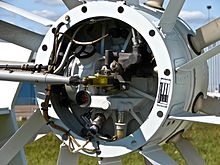Fenestron



A Fenestron is an enclosed tail rotor of a helicopter with a tail rotor configuration. It serves to balance the torque of the main rotor and is built into the tail boom as a ducted propeller . Airbus Helicopters and its predecessor companies used this technology most often. The Fenestron was first used by Sud Aviation .
etymology
The term “fenestron” comes from the Occitan expression fenestrou , roof window, dormer window, which in turn is derived from the Latin fenestra meaning “window”. The name fenestrou for this goes back to Paul Fabre from Sud Aviation . However, the head of the development department at Sud Aviation, François Legrand, finally changed the name to "Fenestron".
“Fenestron” is trademarked by the French company Sud Aviation, which has now been absorbed by Airbus Helicopters (previously Eurocopter Group ) .
history
There was already a patent for this idea from the Scottish company G. & L. Weir Ltd , where it was developed by CG Pullin. In the UK this was patented in May 1943 under the number 572,417th The Weir company was active in the gyroplane sector at that time .
The Fenestron tail rotor was used for the first time at the end of the 1960s on the second test model of the SA 340, the later model Aérospatiale SA 341 Gazelle . Subsequently, the technology was used more frequently and was thereby further refined, as in the Aérospatiale Dauphin , and during that time first by the DASA developed EC 135 . A merger of the helicopter divisions of DASA and Aérospatiale in 1992 resulted in Eurocopter, today's Airbus Helicopters. In addition to Airbus Helicopters and its predecessors, the Fenestron was used in a new prototype of the Sikorsky S-76 (only B variant) and also in the US military helicopter project Boeing-Sikorsky RAH-66 Comanche , which was discontinued in 2004.
In 2018 the Fenestron had its 50th anniversary because on April 12, 1968 the second prototype of the Sud Aviation Gazelle took off with it for the first time .
Examples of helicopters with Fenestron
Known models in roughly their chronological order:
- Aérospatiale SA 341/342 (Gazelle)
- Aérospatiale Dauphin
- Sikorsky S-76 B
- Airbus Helicopters H135
- Airbus Helicopters H120 (Colibri)
- Kawasaki OH-1
- Mitsubishi MH2000
- Boeing-Sikorsky RAH-66 (Comanche)
- Kamow Ka-60 /62
- Airbus Helicopters H155
- Guimbal Cabri G2
- Airbus Helicopters H145
- WZ-19
- Airbus Helicopters H160
- Bell 360 (Invictus)
technology
While conventional tail rotors have a maximum of 6 rotor blades, fenestrons have between 8 and 18 blades. Some of these are arranged at varying distances so that the operating noise is distributed over several frequencies and thus appears quieter overall. With a smaller diameter, the Fenestron is operated at a higher speed than a normal tail rotor.
- advantages
- Greater safety for people on the ground, as rotating tail rotors are one of the greatest sources of danger in helicopters
- Greater ground clearance of the tail boom and less susceptibility to foreign objects, and in the case of military helicopters also to fire
- Noise development greatly reduced because the blade tips do not rotate freely; this and the higher number of blades also lead to lower vibrations
- Smaller radius with the same thrust and the same power due to the jet expansion due to the geometry of the casing
- disadvantage
- Higher weight due to the encapsulation, so it is only suitable for smaller and medium-sized types, it would be too heavy for large helicopters
- Higher construction costs
- Higher energy consumption due to the smaller size
- Shielding of the tail rotor during fast forward flight (leads to a reduction in effectiveness)
- Higher swirl loss due to eddies in the downstream flow, therefore swirl compensation stators are also installed
See also
- McDonnell Douglas NOTAR (rear rotor-free torque compensation)
literature
- Fenestron. (Episode 24 from the series Aerospace from A to Z) In: Flug Revue No. 4/2017, p. 67
- Chapter 2.3.10. Jacketed rotors. In: BG van der Wall: Fundamentals of helicopter aerodynamics , Springer Vieweg, Berlin, Heidelberg [2015], ISBN 978-3-662-44399-6 , pp. 145 ff.
- 50 years of Fenestron. In: Rotorblatt No. 2/2018, p. 5
Web links
Individual evidence
- ↑ Fenestron. (in the chapter: Explanation of terms) In: K. von Gersdorff, K. Knobling: Helicopter and Gyrocopter , Volume No. 3 from the series “Die deutsche Luftfahrt”, Bernard & Graefe Verlag, Bonn, 3rd expanded edition from 1999, ISBN 3 -7637-6115-2 , p. 330
- ↑ Fenestron. (in the glossary) In: H. Mauch, M. Mau: The large helicopter manual: history, flight technology, deployment , GeraMond Verlag GmbH, Munich 2015, ISBN 978-3-7654-7001-1 , p. 158.
- ↑ a b c History of the fenestron. In: ROTOR on line No. 72 from August / September 2007 , accessed on November 16, 2016
- ↑ Airbus Helicopters celebrates 50 years of Fenestron , accessed on May 7, 2018
- ↑ rth.info: EC 135 Characteristic , accessed on November 16, 2016
